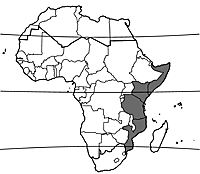Bullockia mombazensis (PROTA)
Introduction |
Bullockia mombazensis (Baill.) Razafim., Lantz & B.Bremer
- Protologue: Ann. Missouri Bot. Gard. 96(1): 175 (2009).
- Family: Rubiaceae
Synonyms
- Canthium mombazense Baill. (1878).
Vernacular names
- Mfupapu, kifuwahe (Sw).
Origin and geographic distribution
Bullockia mombazensis is distributed in Somalia, Kenya, Tanzania and Mozambique.
Uses
The stems are often used as poles in house construction. The fruit is very sweet and edible.
Description
- Evergreen, usually dioecious shrub or small tree up to 7.5 m tall; outer bark smooth or fissured, pale grey; twigs glabrous or occasionally short-hairy.
- Leaves opposite, simple and entire; stipules ovate, 4–16 mm long, acuminate at apex; petiole 2–20 mm long; blade broadly oblong-elliptical to nearly round, 2–13 cm × 1–7.5 cm, base obtuse to rounded, often oblique, apex obtuse to rounded, leathery, glabrous or sometimes hairy beneath, pinnately veined with 4 main pairs of lateral veins.
- Male inflorescence a sessile umbel, 3–20-flowered; female flowers solitary.
- Flowers functionally unisexual, regular, 5–6-merous; pedicel 3–10 mm long; calyx with tube up to 2.5 mm long and lobes up to 3 mm long; corolla whitish or yellowish green, tube c. 1.5 mm long, with a ring of deflected hairs at throat inside, lobes triangular-ovate, 1–1.5 mm long; stamens inserted in corolla throat alternating with lobes, anthers nearly sessile; ovary inferior, 2-celled, style slightly longer than corolla tube, with distinct pollen carrier at apex; functionally male flowers with short calyx tube and rudimentary ovary, functionally female flowers with longer calyx tube and sterile stamens.
- Fruit an obovoid drupe 7–12 mm × 7–9 mm, laterally compressed, dark brown-red, crowned by persistent calyx lobes, with 2 stones; stones obovoid, c. 7 mm × 3.5 mm, flattened, smooth except for shallow crest around apex, 1-seeded.
Other botanical information
Bullockia mombazensis is usually dioecious, but occasionally polygamous. In the Shimba Hills (south-eastern Kenya) fruits of Bullockia mombazensis are found in (June–)July–August(–October). They are eaten by animals such as civets, elephants and baboons, which contribute to seed dispersal.
Bullockia comprises 8 species, of which 6 in East and southern Africa and 2 in Madagascar. It was formerly included in Canthium as a subgenus.
Bullockia dyscriton
Bullockia dyscriton (Bullock) Razafim., Lantz & B.Bremer (synonym: Canthium dyscriton Bullock) is a shrub up to 3 m tall, distributed in Kenya and Tanzania. Its wood is used for making arrow heads.
Ecology
Bullockia mombazensis occurs in coastal bushland, wooded grassland and evergreen forest, from sea-level up to 1200 m altitude.
Management
In experiments in Kenya seed germination was slow, with first emergence of seedlings 74 days after sowing. The stems are locally collected; they are sometimes traded.
Genetic resources
Bullockia mombazensis has a limited distribution, but is common and locally abundant in its distribution area, and seems not threatened with genetic erosion.
Prospects
Bullockia mombazensis is a useful local source of poles for house construction. Information on its wood properties is lacking, but in view of its small size its importance is unlikely to increase.
Major references
- Bridson, D. & Verdcourt, B., 2003. Rubiaceae (Cinchonoideae). In: Pope, G.V. (Editor). Flora Zambesiaca. Volume 5, part 3. Royal Botanic Gardens, Kew, Richmond, United Kingdom. 720 pp.
- Engel, T.R., 2000. Seed dispersal and forest regeneration in a tropical lowland biocoenosis (Shimba Hills, Kenya). PhD thesis, Faculty of Biology, Chemistry and Geosciences, University of Bayreuth, Germany. Logos Verlag, Berlin, Germany. 345 pp.
- Pakia, M., 2000. Plant ecology and ethnobotany of two sacred forests (kayas) at the Kenya coast. Volume 1. MSc thesis, University of Natal, Durban, South Africa. 358 pp.
- Razafimandimbison, S.G., Lantz, H., Mouly, A. & Bremer, B., 2009. Evolutionary trends, major lineages, and new generic limits in the dioecious group of the tribe Vanguerieae (Rubiaceae): insights into the evolution of functional dioecy. Annals of the Missouri Botanical Garden 96(1): 161–181.
- Verdcourt, B. & Bridson, D., 1991. Rubiaceae (part 3). In: Polhill, R.M. (Editor). Flora of Tropical East Africa. A.A. Balkema, Rotterdam, Netherlands. pp. 749–957.
Other references
- Beentje, H.J., 1994. Kenya trees, shrubs and lianas. National Museums of Kenya, Nairobi, Kenya. 722 pp.
- Bridson, D.M., 1987. Studies in African Rubiaceae - Vanguerieae: a new circumscription of Pyrostria and a new subgenus, Canthium subgen. Bullockia. Kew Bulletin 42(3): 611–639.
- Bridson, D., Thulin, M. & Degreef, J., 2006. Rubiaceae. In: Thulin, M. (Editor). Flora of Somalia. Volume 3. Angiospermae (cont.). Royal Botanic Gardens, Kew, Richmond, United Kingdom. p. 61–110.
- Burgess, N.D. & Clarke, G.P., 2000. Coastal forests of Eastern Africa. IUCN, Gland, Swizerland. 443 pp.
- Medley, K.E. & Kalibo, H.W., 2007. Ethnobotanical survey of 'wild' woody plant resources at Mount Kasigau, Kenya. Journal of East African Natural History 96(2): 149–186.
Author(s)
- M. Brink, PROTA Network Office Europe, Wageningen University, P.O. Box 341, 6700 AH Wageningen, Netherlands
Correct citation of this article
Brink, M., 2012. Bullockia mombazensis (Baill.) Razafim., Lantz & B.Bremer. [Internet] Record from PROTA4U. Lemmens, R.H.M.J., Louppe, D. & Oteng-Amoako, A.A. (Editors). PROTA (Plant Resources of Tropical Africa / Ressources végétales de l’Afrique tropicale), Wageningen, Netherlands. <http://www.prota4u.org/search.asp>.
Accessed 31 March 2025.
- See the Prota4U database.

